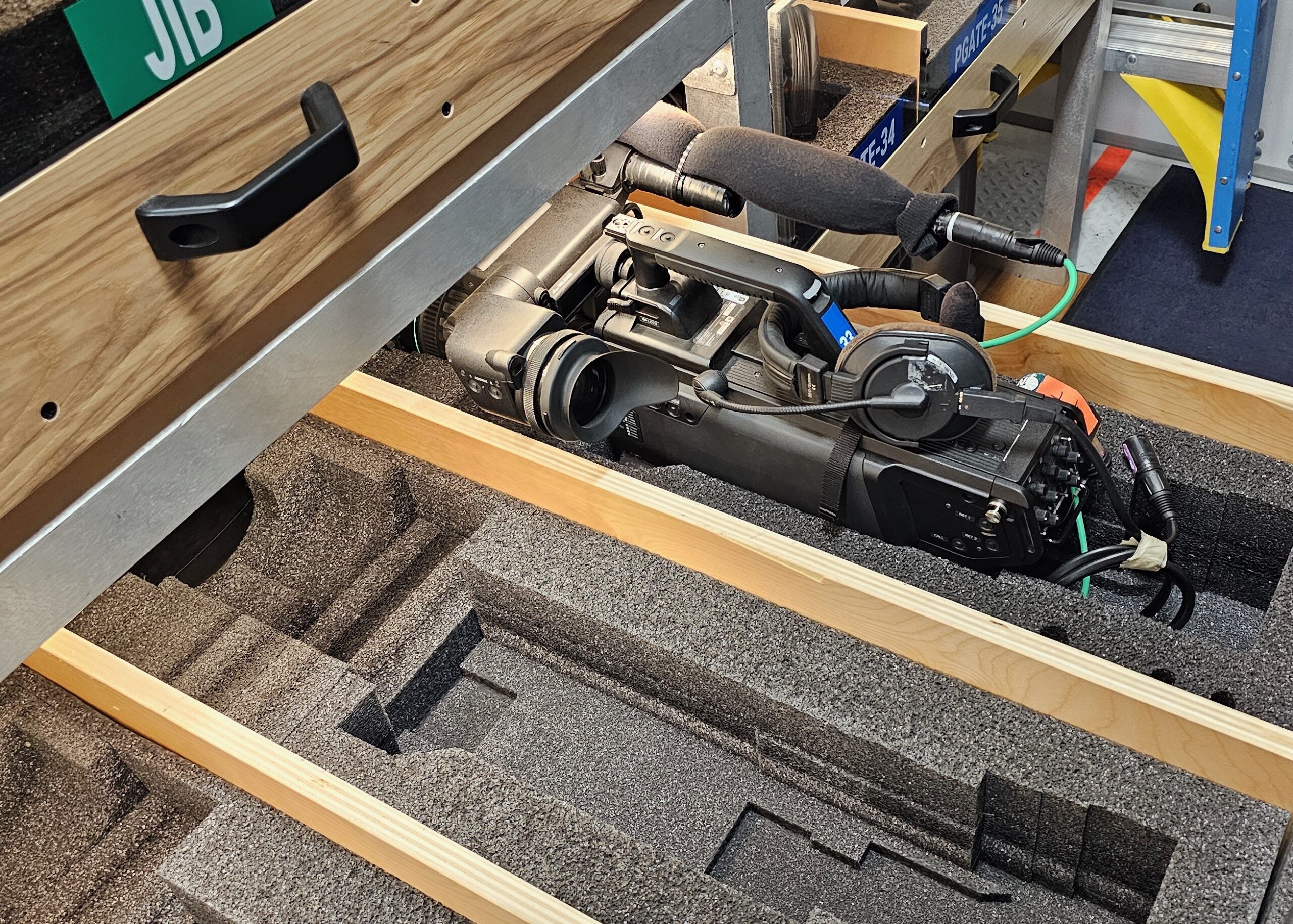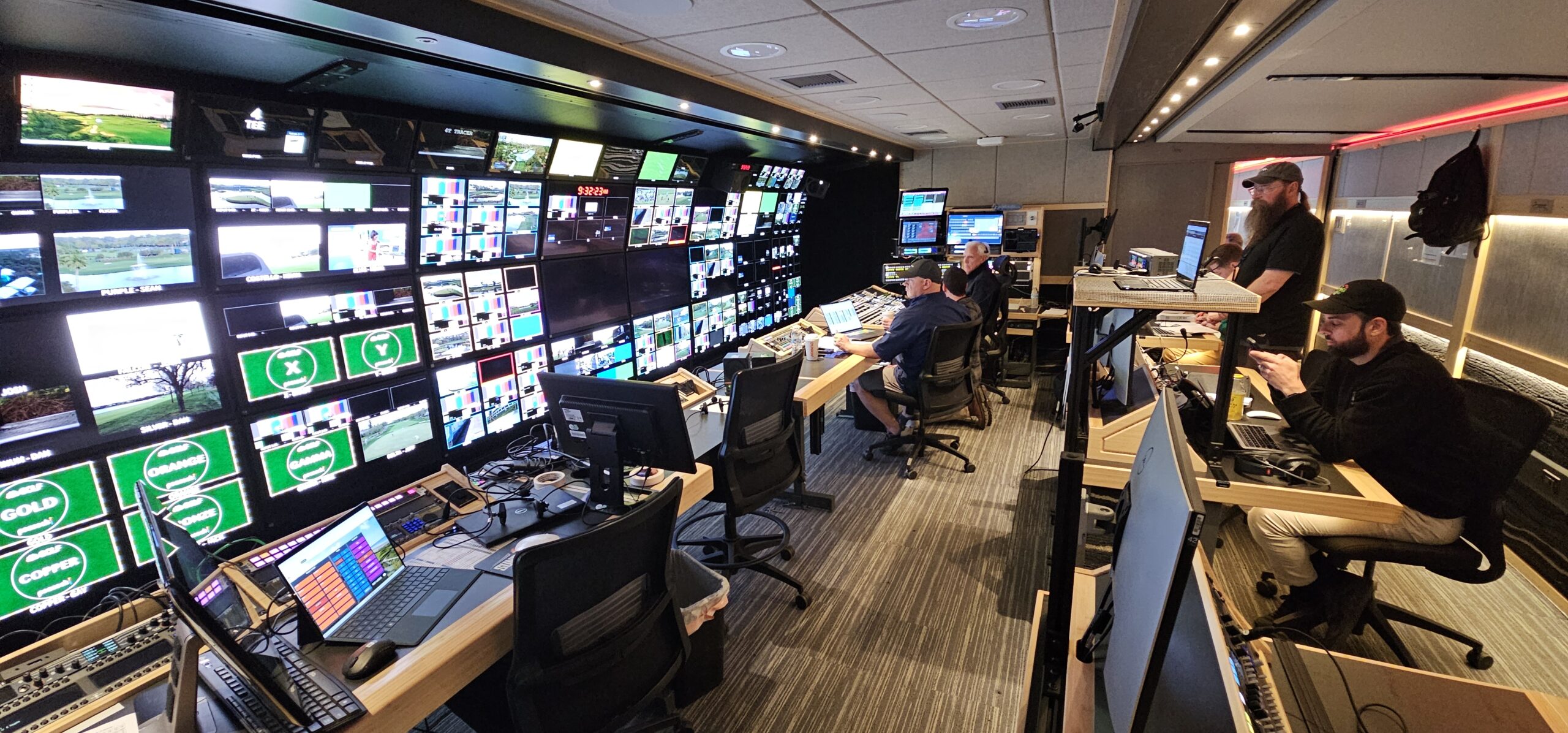Live From THE PLAYERS Championship: PGA TOUR Fleet of Trucks Transforms Setup, Coverage
Built by NEP, the new units make a difference at their first large-scale production
Story Highlights
The 2024 PLAYERS Championship this weekend is simultaneously the end of an era and the beginning of a new one. The new era: the debut of the PGA TOUR fleet at the PLAYERS Championship (the trucks have been on the road for six weeks for both CBS Sports and NBC Sports events). The era ending: operations that have historically been done at the PGA TOUR Entertainment facility in St. Augustine, FL, will be handled down the road at PGA TOUR Studios, a 165,000-sq.-ft. facility scheduled to be up and running next year next to the TPC Sawgrass course.
Eight of the PGA TOUR trucks are onsite (the ninth is in Palm Harbor, FL, helping get fiber runs in place for next week’s Valspar Championship). The Production Control Room (PCR) unit houses the main production area. Field Acquisition Units 1 and 2 contain video shading, the A1 area, submix, and the majority of QC for audio. The Record Flex truck is home to EVS operations, ARL operations (with an additional three operators working remotely from New Zealand), and rules review. The other trucks onsite are a main truck, which is now a double-wide; a hauler providing up to 36 RF camera paths; an office trailer; and two BSI trailers.
Owned, constructed, managed, and operated by NEP Broadcasting, the fleet has been operating smoothly since its first event at Torrey Pines in San Diego. “The launch was smooth between the two networks,” notes Mike Raimondo, VP, broadcast technology, PGA TOUR. “The biggest thing was, we ran into the ‘Oh, by the ways’ with requests for things like converters. Even the HDR transition between CBS and NBC overall was pretty smooth. They do HDR differently — NBC likes to do shading at 200 nits while CBS uses 180 nits — but the trucks are flexible enough that they can handle either one. And so much went into how the PCR truck was laid out that, even though [NBC and CBS] may sit in different ways, we can change things.”
NBC Sports and Golf Channel Producer Tommy Roy was skeptical that the PCR could meet his team’s needs, but seeing it at NEP’s Pittsburgh facility made him a believer: “I was blown away, and I’ve worked in a lot of spectacular trucks. And this truck will do golf every week, so we won’t have to come here and change the monitor wall around [after it does other events].”
He adds that the acoustics are perfect. “[In other trucks,] sound can echo off the roof, and it can get loud. This truck doesn’t have that,” he explains. “All the technology in here is better than in the previous truck.”
As for changes that suit his needs versus those of Sellers Shy, lead golf producer, CBS Sports, Roy cites the removal of a notch of trim around the front bench: “I like that because I can sit farther forward, see around the director, and see more of the monitors. The changes can be as silly as that.”
Changes Boost Efficiency
Efficiency is the name of the game when it comes to the PGA TOUR fleet in action. It begins with small things that make it much easier to get the trucks parked, powered, and connected quickly. Color coding, for example, gives each truck its own railing color to identify it.
“The sleeve of our fiber is also color-coded,” notes Raimondo. “When trucks are hooked up every week, color coding tells you where each of the fibers goes. It’s just plug-and-play: green to green, red to red, etc.”
Another efficiency is credited to the large BSI trailers housing the wireless-camera and -audio operations. First, there is plenty of room in one of the trailers for not only the 240+ radios that have to be deployed across the course but also the batteries that have to be charged. The real time-saver is new custom foam padding for each camera case, which ends the days of having to repeatedly take cameras apart and put them together again.

Custom-made foam inserts allow for cameras to be stored as a package, removing the need to assemble them before every event.
“It’s a complete package with the cameras and RF gear already attached,” says Raimondo. “When the crew shows up, they just pull it out of the case and hand it to the cameraperson, and they’re off and running. We used to need tables to take everything apart and then put it together, and now they just pull it out of the case. That goes for the radios and chargers as well.”
The utility truck is also neatly organized, making it easy to find everything from zip ties to connectors to cables and more.
The whole fleet is IP, using ST 2110, and also runs at 1080p HDR. All signals from the course pass into the Field Acquisition Units and then, via NEP’s TFC (Total Facility Control), are available to all the other trucks in the compound.
The two field units are basically duplicates, except that one has two audio rooms and the other has an audio room used for PGA TOUR Radio and a Trackman operation, as well as two Fletcher robot-operator positions.
“Both are wired for 36 camera-control units and have six video positions and the exact same patch panel,” says Raimondo. “All the field fiber runs into Field Unit 1, where we also have all the main interconnects for the other trucks.”
NEP Broadcast Services President Glen Levine had his first chance to see the new PLAYERS compound, with not only the PGA TOUR fleet but also NEP ND2, handling NBC Sports production overflow, and Supershooter CBS, producing Every Shot Live. “It’s an incredible compound with the newest technology across the entire group of NEP trucks,” he says, noting, “And it’s full IP and under full TFC control.”
For Dan Beard, senior director, remote media production facilities, PGA TOUR, the key is that everything is file-based, allowing signals to be routed wherever needed. “We don’t have to run copper everywhere,” he points out. “And we’ve [eliminated] a multidimensional DA truck in the middle of the compound, which every source has to hit [before being] sent to trucks. Now, if someone in a truck wants a signal, they can just grab it, because everything is available to everyone across the board.”

